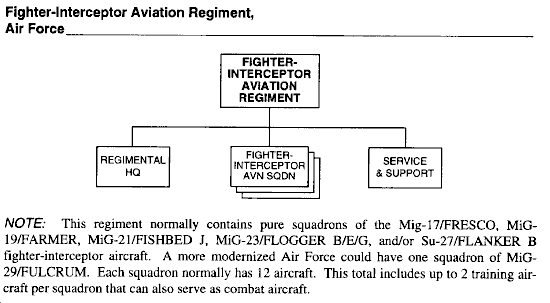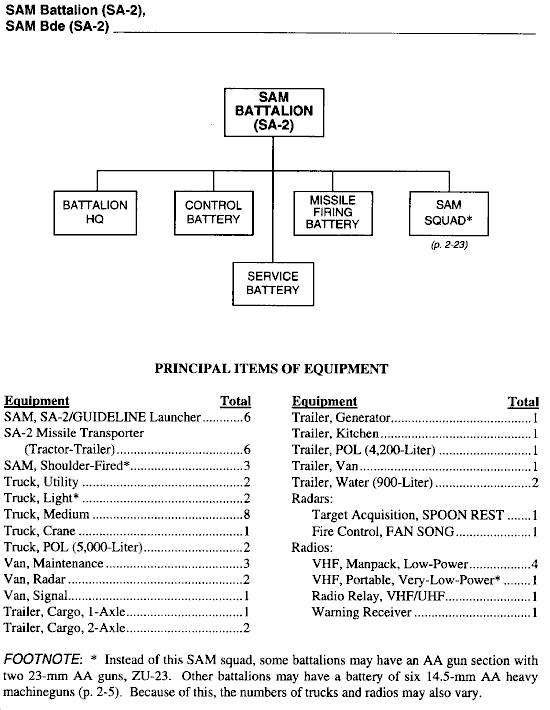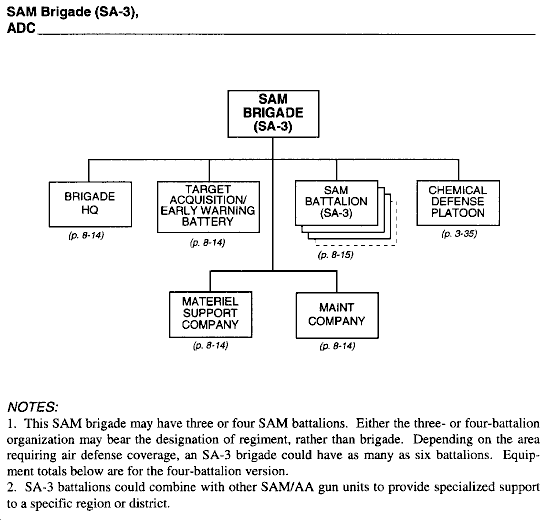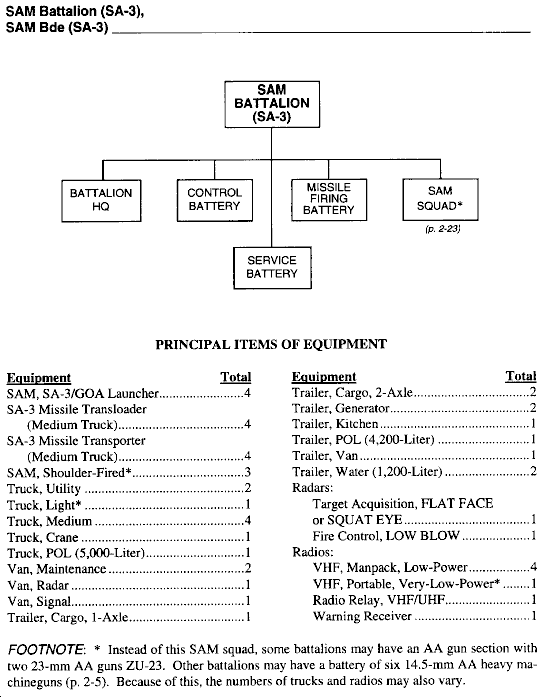Troops of National Air Defense (PVO)
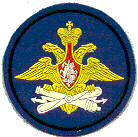 The Troops of National Air Defense (PVO) became a separate armed service in 1948 and were given the mission of defending the Soviet industrial, military, and administrative centers and the armed forces against strategic bombing. After Air Defense of Ground Forces was formed in 1958, the National Air Defense Forces focused on strategic aerospace and theater air defense.
A major reorganization of Soviet Air and Air Defence Forces took place between 1978 and 1980, including Frontal Aviation, Long-Range Aviation, interceptor aircraft of the National Air Defence (IA-PVO) and Ground Force Troops of the Anti-Aircraft Defence (PVO Voysk). PVO Strany was reorganized in 1981 and its name was changed to Voyska PVO (Air Defence Troops), but it maintained its status as an independent branch, and the main body of army air defence troops, including the military schools, were annexed to it. Voyska PVO yielded responsibility for theater antiaircraft systems to Air Defense of Ground Forces. The Voyska PVO lost its separate command and control system in the reorganization and about half of the fighters and the majority of the flying training system was transferred to the Air Force.
The Troops of National Air Defense (PVO) became a separate armed service in 1948 and were given the mission of defending the Soviet industrial, military, and administrative centers and the armed forces against strategic bombing. After Air Defense of Ground Forces was formed in 1958, the National Air Defense Forces focused on strategic aerospace and theater air defense.
A major reorganization of Soviet Air and Air Defence Forces took place between 1978 and 1980, including Frontal Aviation, Long-Range Aviation, interceptor aircraft of the National Air Defence (IA-PVO) and Ground Force Troops of the Anti-Aircraft Defence (PVO Voysk). PVO Strany was reorganized in 1981 and its name was changed to Voyska PVO (Air Defence Troops), but it maintained its status as an independent branch, and the main body of army air defence troops, including the military schools, were annexed to it. Voyska PVO yielded responsibility for theater antiaircraft systems to Air Defense of Ground Forces. The Voyska PVO lost its separate command and control system in the reorganization and about half of the fighters and the majority of the flying training system was transferred to the Air Force.
Around 1980 the In 1989 the Air Defense Forces had more than 500,000 personnel and operated the world's most extensive strategic air defense network. By the mid-1990s the air defense forces had a total of about 200,000 troops, of whom 60,000 were conscripts, with about 850 combat aircraft, including 100 MiG-23, 425 MiG-31, and 325 Su-27 aircraft.
As a part of the organizational reform aimed at increasing efficiency and cutting military personnel, the Air Defense Force was merged with the Air Force in 1998. On 11 August 2000 the Air Force commander-in-chief, Army Gen Anatoliy Kornukov, announced that Russian air defence missile units would soon stop being on a permanent combat duty for financial reasons. The units will be kept at a lower level of readiness, with primary air defense responsibilities being placed on fighter aviation. The air defense forces, charged with defense against enemy air attack, include missile, air force, and radio-technical units. The strategic air defense operation focuses on defending friendly forces and contributing to air superiority. Defensive tasks, in order of priority, include--- Protecting administrative-political, military-industrial, and communications centers.
- Providing cover for air bases, missile troops, and major headquarters.
- Defending concentrations and deployments of major ground forces groupings, especially on main axes, and then of second echelons or reserves.
The reorganization of the command and control structure for Soviet air assets, which began in the late 1970s occurred as part of the general reorganization of Soviet military forces and is a result of the new emphasis on TVDs as the basic level of military operations in a future war. The reorganization resulted in a streamlined organization due to the merger of strategic and tactical air and air defense assets in most land border areas of the USSR. The air defense (APVO) interceptor regiments in these areas were resubordinated from PVO Strany to the Soviet Air Forces. They became part of a new structure, the "Air Forces of the Military District," which also included most of the assets of the former tactical air armies.
Western experts disagreed over the system of air defense districts. Some argued that as many as ten air defense districts, separate from military districts, still existed. It seemed more likely, however, that when the National Air Defense Forces became the Air Defense Forces after 1980, all remaining air defense districts were integrated into the military districts. At that time, commanders of the Air Defense Forces became deputy commanders of the military districts. Only the Moscow Air Defense District continued to be mentioned in the press, possibly because it operated the ABM system that protected the capital city and the National Command Authority.
As of the mid-1990s Seven of the military districts had at least one aviation air defense regiment each; two districts, Moscow and the Far Eastern, had specially designated air defense districts. The borders of the Moscow Air Defense District were the same as those of the Moscow Military District. The Far Eastern Air Defense District combined the territory of the Far Eastern Military District and the Transbaikal Military District. Presumably, the boundaries of the other military districts were the same for air defense as for other defense designations.
Air Defense Aviation had the mission of preventing aircraft and cruise missiles from entering Soviet airspace. In wartime it would strive to establish air superiority and provide air cover for Frontal Aviation's deep strike and ground attack aircraft. In 1989 Air Defense Aviation had 2,000 fighter-interceptor aircraft organized into air regiments. The Su-15, MiG-23, and MiG-25, first produced in the late 1960s and early 1970s, constituted 80 percent of Air Defense Aviation's inventory. The Soviet Union's newest interceptors, the MiG-31 and Su-27, deployed in the early 1980s, represented 10 percent of the force in 1989. These new fighter-interceptors had "look-down, shoot-down" radars for engaging aircraft and cruise missiles penetrating Soviet airspace at low altitudes. Since the mid-1980s, the Soviet Union has built four new airborne warning and control system (AWACS) aircraft on an Il-76 airframe. These AWACS aircraft have improved Air Defense Aviation's ability to direct interceptors against enemy bombers, fighters, and cruise missiles in aerial combat.By the mid-1990s the air defense forces operated twenty Il-76 aircraft configured for airborne early warning and command and control. The air force troops operated their own training program from one training center that included four regiments equipped with more than 380 MiG-23 and L-39 aircraft.
The main focus of fighter aviation efforts is on protecting the main strike group, airfields, SSM deployment areas, key CPs, and logistics installations. The PVO expects enemy air power to attack across a broad frontage with a large number of aircraft operating in small groups echeloned both in height and depth. To repel such attacks, the operational formation of fighter aviation is in several echelons, including two to three at low altitude and two at high altitude. The purpose of the first echelon is to engage the enemy on distant approaches. For this mission, it uses the best pilots to conduct independent "free hunt" sweeps in enemy airspace, beyond the reach of friendly SAMs. The PVO commits the second echelon in the area of the line of contact or somewhat over it. Fighters on standby at airfields reinforce and develop the operations of forward fighter elements. To intercept small groups or individual aircraft, each fighter division has a sector of responsibility. Within that sector, it destroys targets according to the decision of the fighter division commander, by the simultaneous commitment of not more than one-third of the available aircraft. The demands placed on air forces are great and growing. In the past, it was unlikely that substantial numbers of aircraft would be able to switch roles, from the counterair battle to offensive air support. This should be more likely in the future, at least from a technological viewpoint. New aircraft types and improved munitions are increasing both capabilities and flexibility. Nevertheless, given the time and casualties required to establish air superiority, it remains uncertain whether changing roles from a defensive to an offensive posture could be achieved within a time frame acceptable to the ground forces. Still, this possibility is important when assessing any defensive strategy.In 1989 the Antiaircraft Rocket Troops manned 12,000 strategic surface-to-air missile launchers at 1,400 sites inside the Soviet Union. These forces were organized into brigades of launch battalions. Soviet SA-3 and SA-5 antiaircraft missiles, first produced in the 1960s, together with older SA-1 and SA-2 missiles, constituted over 90 percent of the Soviet surface-to-air missile inventory. In the late 1980s, the new SA-10 was entering service to replace SA-1 and SA-2 missiles.
By the mid-1990s the missile forces were equipped with approximately 2,500 launchers deployed in about 250 different sites around the country. Air defense forces have particular responsibility for defending administrative and industrial centers; for instance, they surround Moscow with about 100 missile launchers. The missile troops were equipped with about 150 SA-2 Guideline, 100 SA-3 Goa, 500 SA-5 Gammon, and 1,750 SA-10 Grumble missile launchers. A program to replace all of the older systems with the SA-10, well under way by 1996, has been considered by experts to be one of the most successful reequipment programs of the post-Soviet armed forces.
The Troops of National Air Defense (PVO) contained brigades and regiments of either surface-to-air missiles (SAMs) or antiaircraft (AA) guns. Maintaining single-system units allowed the PVO to manage limited assets, tailoring support to a particular region or air defense zone.
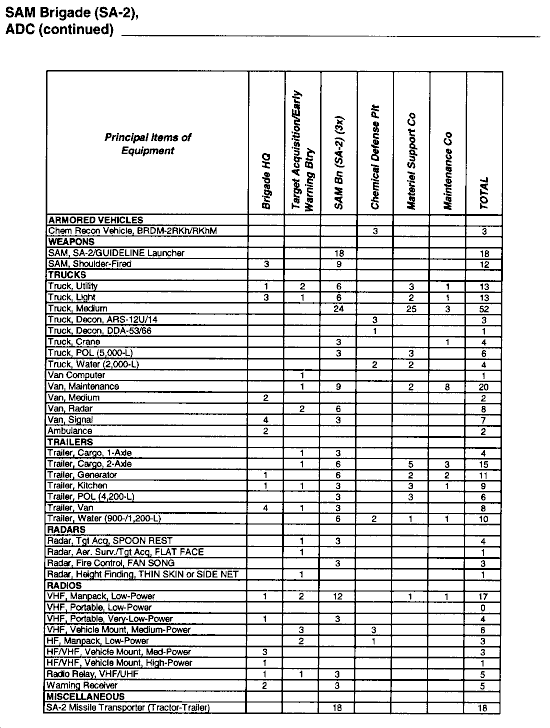
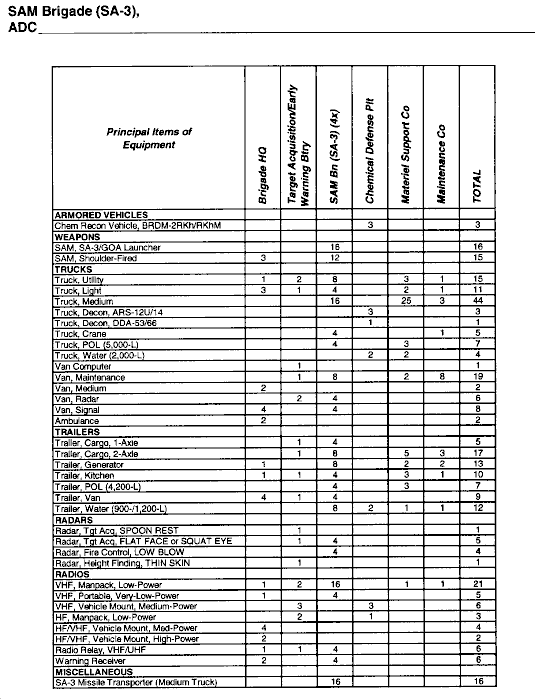
High-level commanders select the weapon system that can best engage a given target. Army group, army, and division target-acquisition radars detect and monitor targets. The radars then provide the necessary data for engagement. They gather the information without unnecessarily exposing the air defense firing battery and radars mounted on transporter-erector-launchers and radars (TELARs) to detection by enemy forces and subsequent neutralization by electronic countermeasures (ECM) or destruction.
Although equipped with numerous modern weapons systems, the Air Defense Forces have made operational errors that raised serious questions about their command, control, and communications systems and training. In September 1983, Soviet interceptors shot down a South Korean passenger jet that strayed into Soviet airspace over Sakhalin. In May 1987, Mathias Rust, a citizen of the Federal Republic of Germany (West Germany), flew his private airplane into Soviet airspace and landed in Red Square in Moscow. As a result, the commander in chief of the Air Defense Forces, a former fighter pilot, was fired and replaced with a high-ranking Ground Forces officer who had extensive combined arms experience.Missile and space defenses have been effective arms of the Air Defense Forces since the mid-1960s. In 1989 the Soviet Union had the world's only operational antiballistic missile (ABM) and antisatellite (ASAT) systems. The Soviet Union deployed its first ABM defense system around Moscow in 1964. It consisted of surface-to-air missiles that could be launched to destroy incoming ballistic missiles. The Soviet leaders have continually upgraded and developed the capabilities of this initial system. A major modernization of interceptor missiles began in the late 1970s, and by 1989 the Soviet Union had up to thirty-two improved SH-04 (Galosh) launchers in operation and a fundamentally new SH-08 (Gazelle) interceptor missile under development. In 1989 the Radiotechnical Troops operated eleven ground-based radars and numerous satellites to provide strategic early warning of enemy missile launches. They also manned six large phased-array radars for ballistic missile detection. These radars could also serve as target acquisition and tracking radars to guide ABM launchers as part of a nationwide defense against ballistic missiles. In 1989 the Soviet Union was building three additional sites for phased-array radars. The Soviet Union had an operational ASAT interceptor system that in wartime it would launch a satellite into the same orbit as an opponent's satellite. The ASAT satellite would then maneuver nearby and detonate a conventional fragmentation or a nuclear warhead to destroy its target. Thus, the interceptor system posed a threat to an adversary's command, control, and communications, navigation, reconnaissance, and intelligence gathering satellites in low-earth orbits, a capability that would be critical in wartime.




